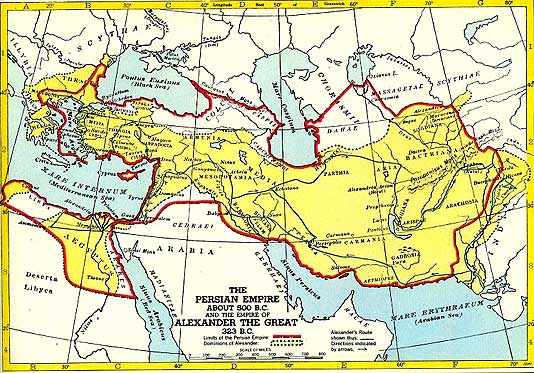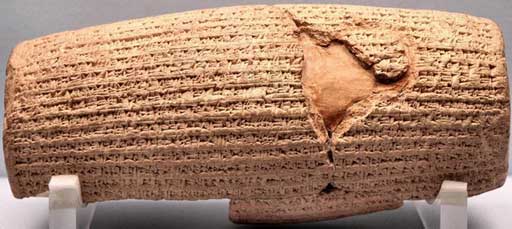

From eastern Europe all the way to Mongolia and Manchuria in eastern Asia stretches 6,000 miles of dry grasslands known as steppes. The Eurasian steppes are bordered on the north by the taiga, boreal pine forests, and on the south by the Tibetan plateau and various deserts of southwest Asia. Early farmers probably began moving into the steppes by 5000 BC, as population increased to the south in southwestern Asia. The steppes however were too dry and often too cold for regular farming, and people moving into the area became pastoralists, depending on herds of sheep, goats, cattle and horses. By 3500 BC, with the invention of wheeled vehicles, the pastoralists also began to expand geographically as they increased numerically. One of the early groups of steppe pastoralists were Indo-Europeans, the name not really of a culture, but today the name of a huge language family that contains languages spoken by almost half the world's people. [Click here for map of Indo-European languages, and here for a language tree--both required sites.] Included in this family are all the European languages except that spoken by the Basque people in Spain, the Indo-Aryan languages of India and southwest Asia, including Hindi, Bengali,Farsi and Urdu, and the Slavic languages, including Russian and Polish.
Unlike the Lapita People and the spread of the Austonesian language family (discussed in unit 2), the origin and spread of the Indo European language family is still not well known in terms of archaeology. Even the original location is in dispute, though some place it in the Eurasian steppes north of the Caspian Sea and Caucasus Mountains, in what is now Kazakhstan and Russia. (See map below for some relevant locations.)

Map of East Europe and Central Asia [Public Domain]
The steppes of Eurasia have often been compared to a giant pump: when the climate became drier in the steppes, people were "pumped" out south, east and west; when the climate was wetter, people were sucked back in. The movements of people in, out, and across the steppes greatly influenced the rise and fall of various empires, and spread the Indo European language family. One of the first movements known archaeologically as well as linguistically was that of the Aryans, who crossed into what is now Pakistan around 1500 BC, and may (or more likely may not) have contributed to the demise of the Indus Valley state. (see lesson/text on Indus) Around 1000 BC the wanderings of the Aryans were written down in the Rig Veda, the foundation book of Hinduism. Shortly thereafter, another migrating group of Indo-European nomads swept into what is now Iran, and became the Persians.
The Persian Empire was the first of a series of large empires roughly centered upon the modern nation of Iran. By 486 BC, the Persians would control all of Mesopotamia and southwest Asia to the Indus Valley, as well as Egypt and ultimately Greece, in the biggest empire the world had yet known. (see map below)

The Persian Empire ca. 500 BC, outlined in Red
Some have claimed that the creation of this great empire was the result of an idea, or perhaps more specifically, a religion. The religion is Zoroastrianism, which perhaps grew from earlier tribal beliefs as early as 6000 BC, and takes its name from its greatest prophet and poet, Zarathustra (Zoroaster in Greek). While certainly a real person, much about him was from oral tradition written down many centuries later. His traditional date of birth is sometimes give as 650 BC, though linguistic evidence from some of the earliest writings would seem to indicate a more likely date of 1600-1700 BC; he is believed to have been born somewhere in eastern Iran, though that too is unknown.
According to Zoroaster, from the beginning of time, the world has been divided into two parts, that of good and evil. Every person must decide for himself whether to follow the wise and good deity, or to follow the dark and evil deity. Humans make the choice, and are ultimately responsible for their own fate. If a person chooses to follow the good path, the reward will be immortality; a person who chooses the bad path will remain forever miserable. The two deities are in an epic struggle, but at the end of time the god of goodness and light will be triumphant. [If you think this sounds somewhat like Judaism, Christianity, and Islam, you are not alone.]
Some historians have said that in the political realm, this notion of choosing to fight for good gave rise to the idea that it could be one's religious duty to conquer the world in the name of the god of goodness and light. If so, the first man to accept this duty was Cyrus the Great. In a series of conquests, including that of Assyria and Babylon, Cyrus established what is sometimes known as the Achaemenid Empire (after the the line of kings from which Cyrus descended) by 546 BC.
When he conquered Babylon, Cyrus freed some 40,000 Jews who had been held captive there, encouraged them to return to Jerusalem, and reportedly helped them rebuild the Temple of Solomon that had been destroyed by the Babylonians. He left the Cyrus Cylinder in Babylon, an account of how bad the previous rulers of Babylon had been, and the many reforms that Cyrus would make. Some have interpreted the Cyrus Cylinder as early statement of human rights, since it banned slavery and oppression, the taking of property without compensation, and called for religious and ethnic freedom. (For this reason the Cyrus Cylinder has become a cultural icon of modern Iran.) In fact Cyrus was known as a ruler who tolerated different religious beliefs; though he brought Zoroastrianism to all the people he conquered, he did not force them to convert. He believed that the Jewish God was aligned with the god of goodness and light. The Jews returned to Jerusalem with many religious ideas of Zoroastrianism, as well as a knowledge of the oral traditions of Mesopotamia. Much of the Old Testament was written into its final form while the Jews were exiled in Babylon. With regard to Zoroastrianism and the notion that it was one's religious duty to spread "the truth", some scholars say these ideas "resurface with a vengeance in Christianity". [ Richard Hooker, in Mesopotamia: The Persians.]

Cuneiform Script on the Cyrus Cylinder [Wikimedia Commons]
Cyrus established a major Persian capital at Persepolis in southern Iran; click here for more information. Though you do not need to read the article, you should click on the pictures at left on the site to view some of the magnificent ruins; click on "photos" at the top for more pictures of the site. After the death of Cyrus in 529 BC, his sons were to conquer Egypt and most of Greece; however by 480 BC Greece had managed to overthrow Persia, and drive the Persians completely out of Europe.
The Persian city of Persepolis, and the Persian empire, were eventually conquered by Alexander the Great, member of another Indo European group, the Macedonians. Macedonia is a modern as well as ancient nation, located just to the north of Greece. Alexander inherited the throne in 336 BC, and with some assistance from Greece, conquered all areas held by the Persians, burning Persepolis. (The area in gold on the map above shows the extent of Alexander's conquests.) Praised in history as a military strategist, Alexander used a force of only 47,000 men against a numerically superior Persian army. Alexander's army was well trained, armed, and possessed body armour, while the Persian army consisted of reluctant conscripts from all over the empire, poorly trained and armed and lacking in body armour. In 333 BC Alexander conquered Syria, in 332 BC Egypt fell, in 331 BC he took Mesopotamia, by 330 he had taken Iran proper, and by 326 BC he had taken the areas of modern Turkmenistan, Uzbekistan, Afghanistan, and the Indus Valley in Pakistan. Everywhere he went he built cities called Alexandria (the most lasting of which was in Egypt) and spread Greek culture; his troops, like so many conquerors and invaders the world over, spread genes. Alexander died in Babylon in 323 BC, only 33 years old. His empire collapsed almost immediately.
In Persia, the Parthians (a northern Iranian group) established themselves and created what is sometimes called the second Persian Empire from 247 BC to AD 224. Though the Parthian Empire was never as large as the first Persian Empire, it was a constant challenge to Rome in the Mediterranean. A new ruling family, the Sassanids, created the third Persian Empire in AD 224, until the Arab armies spreading Islam conquered Iran in 642 AD.